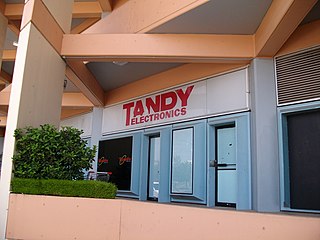
The TRS-80 Micro Computer System is a desktop microcomputer launched in 1977 and sold by Tandy Corporation through their Radio Shack stores. The name is an abbreviation of Tandy Radio Shack, Z80 [microprocessor]. It is one of the earliest mass-produced and mass-marketed retail home computers.

The RadioShack TRS-80 Color Computer, later marketed as the Tandy Color Computer and nicknamed the CoCo, is a line of home computers developed and sold by Tandy Corporation. Despite sharing a name with the earlier TRS-80, the Color Computer is a completely different, incompatible system and a radical departure in design and compatibility with its Motorola 6809E processor rather than the Zilog Z80 earlier models were built around.
Tandy Corporation was an American family-owned leather-goods company based in Fort Worth, Texas, United States. Tandy Leather was founded in 1919 as a leather supply store. By the end of the 1950s, under the tutelage of then-CEO Charles Tandy, the company expanded into the hobby market, making leather moccasins and coin purses, making huge sales among Scouts, leading to a fast growth in sales.
Ground waves are radio waves propagating parallel to and adjacent to the surface of the Earth, following the curvature of the Earth beyond the visible horizon. This radiation is known as Norton surface wave, or more properly Norton ground wave, because ground waves in radio propagation are not confined to the surface.

The MCS-48 microcontroller series, Intel's first microcontroller, was originally released in 1976. Its first members were 8048, 8035 and 8748. The 8048 is arguably the most prominent member of the family. Initially, this family was produced using NMOS technology. In the early 1980s, it became available in CMOS technology. It was manufactured into the 1990s to support older designs that still used it.

In radio communication, skywave or skip refers to the propagation of radio waves reflected or refracted back toward Earth from the ionosphere, an electrically charged layer of the upper atmosphere. Since it is not limited by the curvature of the Earth, skywave propagation can be used to communicate beyond the horizon, at intercontinental distances. It is mostly used in the shortwave frequency bands.

RadioShack is an American electronics retailer founded in 1921. It was initially established as an amateur radio mail-order business centered in Boston, Massachusetts. Its parent company, Radio Shack Corporation, was purchased by Tandy Corporation in 1962, shifting its focus from radio equipment to hobbyist electronic components. At its peak in 1999, Tandy operated over 8,000 RadioShack stores in the United States, Mexico, the United Kingdom, Australia, and Canada.

The SN76489 Digital Complex Sound Generator (DCSG) is a TTL-compatible programmable sound generator chip from Texas Instruments. Its main application was the generation of music and sound effects in game consoles, arcade games and home computers, competing with the similar General Instrument AY-3-8910.

The Realistic DX-300 is a shortwave radio manufactured by General Research of Electronics (GRE) of Chiba, Japan and marketed in the United States by Radio Shack from late 1978 through 1979. The radio's theory of operation is based on the principle of the Wadley Loop and was one of the first radios marketed by Tandy Corporation to have a digital frequency display. The DX-300 was succeeded by the improved DX-302 in 1980.

The TRS-80 Model 100 is a portable computer introduced in April 1983. It is one of the first notebook-style computers, featuring a keyboard and liquid-crystal display, in a battery-powered package roughly the size and shape of a notepad or large book. The 224-page, spiral-bound User Manual is nearly the same size as the computer itself.

The 20-meter or 14-MHz amateur radio band is a portion of the shortwave radio spectrum, comprising frequencies stretching from 14.000 MHz to 14.350 MHz. The 20-meter band is widely considered among the best for long-distance communication (DXing), and is one of the most popular—and crowded—during contests. Several factors contribute to this, including the band's large size, the relatively small size of antennas tuned to it and its good potential for daytime DX operation even in unfavorable propagation conditions.

The Realistic Concertmate MG-1 is an analog synthesizer manufactured by Moog Music in 1981 and sold by Radio Shack from 1982 to 1983 under their "Realistic" brand name. It was produced without some standard Moog features, such as pitch and modulation wheels, as a cost-cutting measure aimed at achieving a lower price for the consumer market. The synthesizer also featured a pair of pass-through RCA jacks, which allowed users to mix radio or records into the final live synthesized sound output.
DXing, taken from DX, the telegraphic shorthand for "distance" or "distant", is the hobby of receiving and identifying distant radio or television signals, or making two-way radio contact with distant stations in amateur radio, citizens band radio or other two-way radio communications. Many DXers also attempt to obtain written verifications of reception or contact, sometimes referred to as "QSLs" or "veries".
Near vertical incidence skywave, or NVIS, is a skywave radio-wave propagation path that provides usable signals in the medium distances range — usually 0–650 km. It is used for military and paramilitary communications, broadcasting, especially in the tropics, and by radio amateurs for nearby contacts circumventing line-of-sight barriers. The radio waves travel near-vertically upwards into the ionosphere, where they are refracted back down and can be received within a circular region up to 650 km from the transmitter. If the frequency is too high, refraction is insufficient to return the signal to earth and if it is too low, absorption in the ionospheric D layer may reduce the signal strength.

Tandy Electronics was an electronics retailer in Australia originally operated by the American Tandy Corporation, later International Tandy (InterTAN), acquired in 2001 by Woolworths Group. The brand ceased to exist after it was phased out by Woolworths Limited in 2011.

The "Wadley-drift-canceling-loop", also known as a "Wadley loop", is a system of two oscillators, a frequency synthesizer, and two frequency mixers in the radio-frequency signal path. The system was designed by Dr. Trevor Wadley in the 1940s in South Africa. The circuit was first used for a stable wavemeter.
The Yamaha FS1R is a sound synthesizer module, manufactured by the Yamaha Corporation from 1998 to 2000. Based on Formant synthesis, it also has FM synthesis capabilities similar to the DX range. Its editing involves 2,000+ parameters in any one 'performance', prompting the creation of a number of third party freeware programming applications. These applications provide the tools needed to program the synth which were missing when it was in production by Yamaha. The synth was discontinued after two years, probably in part due to its complexity, poor front-panel controls, brief manual and limited polyphony.

The TRS-80 Model 4 is the last Z80-based home computer family by Radio Shack, sold from April 1983 through late 1991.

The tellurometer was the first successful microwave electronic distance measurement equipment. The name derives from the Latin tellus, meaning Earth.
Realistic is a brand produced by RadioShack, a division of Tandy Corporation, to market audio and video products for home use. The brand name was phased out in the mid 1990s and discontinued in 2000, then returned briefly in 2016.













